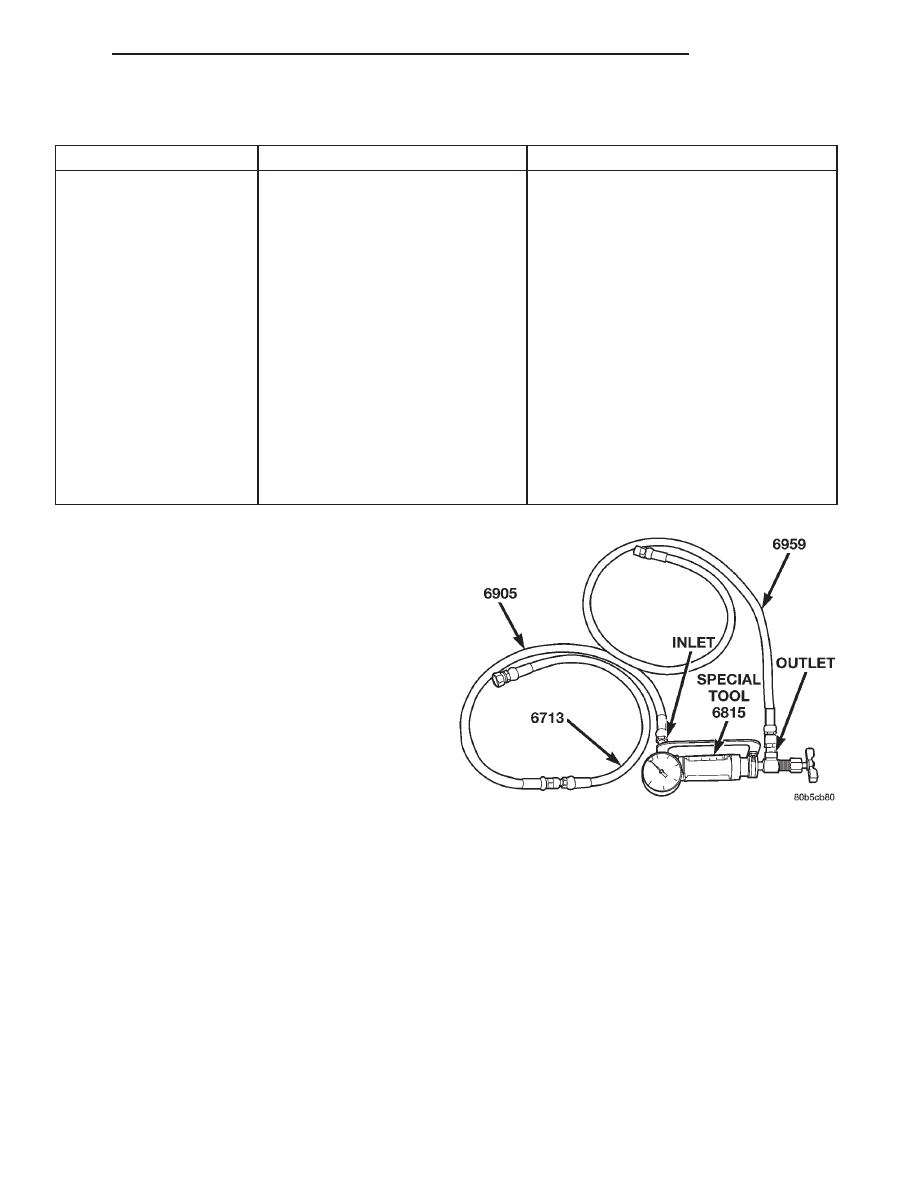Chrysler New Yorker. Manual - part 271

FOAMY OR MILKY POWER STEERING FLUID
CONDITION
POSSIBLE CAUSES
CORRECTION
AERATION AND
OVERFLOW OF FLUID.
1. Air leaks.
1. Check for an air leak into the power
steering system as described under
Sucking Air Diagnosis and correct condition.
2. Low fluid level.
2. Extremely cold temperatures may cause
power steering fluid aeration if the power
steering fluid is low. Add power steering
fluid as required to bring level up to
specification.
3. Cracked power steering pump
housing.
3. Remove power steering pump from
vehicle and inspect the power steering
pump housing for cracks. If a defect in the
housing is found, replace the power
steering pump.
4. Water contamination.
4. Drain the power steering fluid from the
system if there is evidence of
contamination. Then refill the system with
fresh clean power steering fluid.
POWER STEERING SYSTEM FLOW AND
PRESSURE TEST
ALL ENGINES
The following procedure is to be used to test the
operation of the power steering system on this vehi-
cle. This test will provide the flow rate of the power
steering pump along with the maximum relief pres-
sure. This test is to be performed any time a power
steering system problem is present to determine if
the power steering pump or power steering gear is
not functioning properly. The following flow and pres-
sure test is performed using the Power Steering Ana-
lyzer Kit, Special Tool 6815 (Fig. 4), hoses, Special
Tools 6905 and 6959, and fittings from adapter kit,
Special Tool 6893.
(1) Assemble hoses on Power Steering Analyzer,
Special Tool 6815, as shown. Install Pressure Hose,
Special Tool 6905 (in 6893 kit), in the inlet fitting on
Power Steering Analyzer. Install Pressure Hose, Spe-
cial Tool 6713 (in 6815 kit) on Pressure Hose, Special
Tool 6905. Install Pressure Hose, Special Tool 6959,
in the outlet fitting on Power Steering Analyzer.
Install the following adapters from Adapter Set,
Special Tool 6893(Fig. 5), on the analyzer hose ends:
• 2.7L engine — Install Adapter Fitting, Special
Tool 6844, on Pressure Hose, Special Tool 6713.
• 3.2L or 3.5L engine — Install Adapter Fitting,
Special Tool 6825, on Pressure Hose, Special Tool
6713.
• All models — Install Adapter Fitting, Special
Tool 6826, on Pressure Hose, Special Tool 6959.
CAUTION: To prevent personal injury, safety gog-
gles should be worn at all times when performing
any test procedures on the power steering pump or
power steering gear.
The following procedure is to be used to test the
operation of the power steering system on the vehicle.
(2) Check belt tension and adjust as necessary.
NOTE: On vehicles with 3.2 and 3.5 liter engines, it
may be easier to access the power steering pump
pressure fitting from the bottom of the vehicle
engine compartment.
(3) Disconnect the power steering fluid pressure
hose from the power steering pump (Fig. 6) (Fig. 7).
Fig. 4 Power Steering Analyzer With Hoses Installed
300M
STEERING
19 - 9
DIAGNOSIS AND TESTING (Continued)